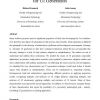Free Online Productivity Tools
i2Speak
i2Symbol
i2OCR
iTex2Img
iWeb2Print
iWeb2Shot
i2Type
iPdf2Split
iPdf2Merge
i2Bopomofo
i2Arabic
i2Style
i2Image
i2PDF
iLatex2Rtf
Sci2ools
JSS
2010
2010
Towards a general purpose architecture for UI generation
Many software projects spend a significant proportion of their time developing the User Interface (UI), therefore any degree of automation in this area has clear benefits. Such automation is difficult due principally to the diversity of architectures, platforms and development environments. Attempts to automate UI generation to date have contained restrictions which did not accommodate this diversity, leading to a lack of wide industry adoption or standardisation. The authors set out to understand and address these restrictions. We studied the issues of UI generation (especially duplication) in practice, using action research cycles guided by interviews, adoption studies and close collaboration with industry practitioners. In addressing the issues raised in our investigation, we identified five key characteristics any UI generation technique would need before it should expect wide adoption or standardisation. These can be summarised as: inspecting existing, heterogeneous back-end arch...
| Added | 29 Jan 2011 |
| Updated | 29 Jan 2011 |
| Type | Journal |
| Year | 2010 |
| Where | JSS |
| Authors | Richard Kennard, John Leaney |
Comments (0)

